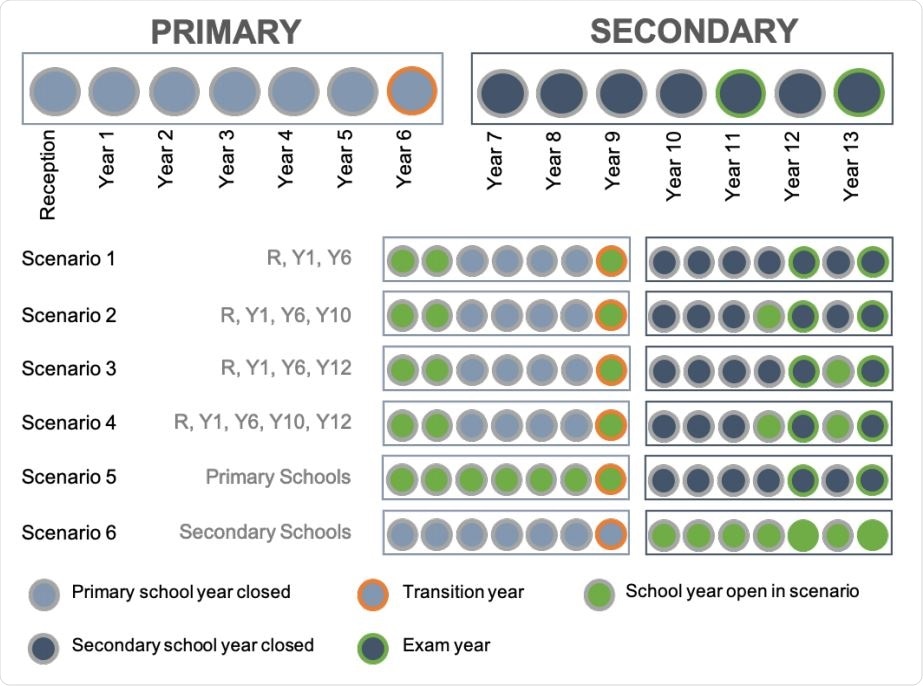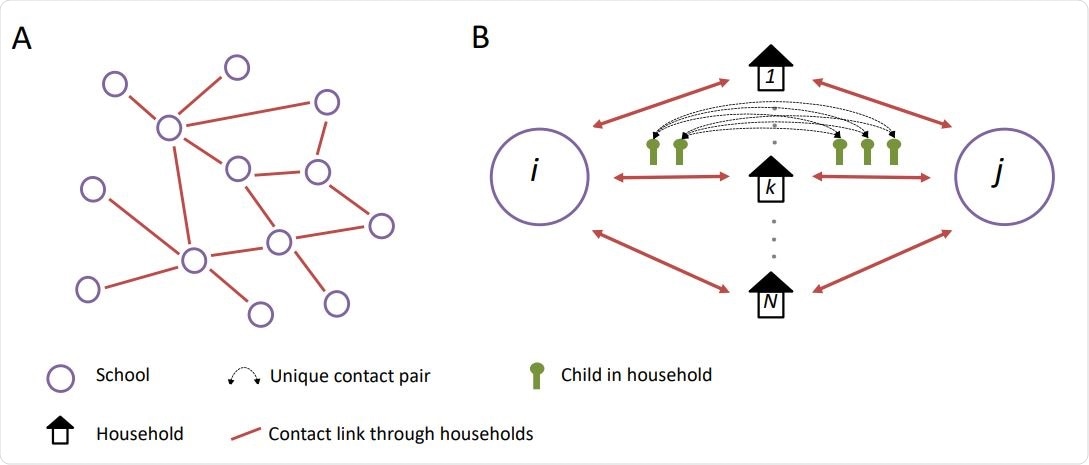A study conducted by researchers at the London School Of Hygiene and Tropical Medicine, University of Edinburgh, and Leiden University, suggests that only reopening schools to specific age groups would reduce the risk of severe acute respiratory syndrome coronavirus 2 (SARS-CoV-2) being transmitted between schools and subsequently households.
Reopening secondary school years will probably increase the risk of transmission much more than reopening to primary school years, says James Munday from the London School of Hygiene & Tropical Medicine and colleagues.
The results suggested that reopening to only primary school years 1 and 6 would result in the least risk of transmission between schools and households, whereas also reopening to even just a small group of secondary school years (10 and 12) would significantly increase the risk.
Of all the scenarios evaluated, the most significant risk of transmission between schools and households was predicted if all secondary school years (11 to 18 year-olds) were to open. This resulted in up to half of the households connected to schools being at risk of infection if the sustained transmission in schools was assumed.
“Keeping transmission within schools limited is essential for reducing the risk of large outbreaks amongst school-aged children and their household members,” said Munday and team.
A pre-print version of the paper is available in the server medRxiv*, while the article undergoes peer review.

Breakdown of school years in England and reopening scenarios evaluated.
“It remains an open question whether reopening schools might increase transmission”
School closure is a well-established, effective, non-pharmaceutical intervention that has been established in many countries globally, including the UK, to help limit the spread of SARS-CoV-2 – the agent that causes coronavirus disease 2019 (COVID-19).
However, school closure is associated with substantial economic and societal costs. Parents staying at home to look after children may impact household income and economic activity for example, and children missing out on education could potentially affect the skill level of the future workforce and, therefore, the growth of the economy.

A network of schools linked by households. A) A network of schools constructed such that schools are connected when contact is made between pupils of different schools within a household. B) The strength of contact between schools is quantified by calculating the number of unique contact pairs (one child in each school). The number of pairs per household is the product of the number of children who attend school i and the number of children who attend school j. The total number of unique pairs is the sum of unique pairs over all, N, households, k, with children attending both school i and j.
School closures were introduced in the UK on 23rd March 2020, and schools remain closed to children of all ages. However, they are due to start reopening at the beginning of the new academic year this September.
Although the prevalence of COVID-19 among school-age children is low, the role children play in SARS-CoV-2 transmission remains unclear.
“It remains an open question whether reopening schools might increase transmission within the community and therefore lead to a resurgence of the disease in the population,” say Munday and colleagues.
While lockdown measures were introduced with the aim of removing links of networks so that infection chains could not reach beyond households, reopening schools could potentially reconnect households and create longer chains of transmission, they say.
“As governments begin to relax restrictions on public life, there is a need to understand the potential impact that reopening schools may have on transmission,” writes the team.
Now, the researchers have used a large dataset of household addresses provided by the UK Department for Education to create a network of schools in England that were connected through pairs of pupils sharing the same household.
The network was used to assess the likelihood of transmission between schools and for far-reaching transmission across the network in various different reopening scenarios.

A) A schematic of a contact network, the width of the edges shows the number of unique contact pairs between schools. B) A schematic of a transmission probability network calculated from the contact network; the shading of the edges shows the relative probability of transmission between schools. C) A schematic of a realisation of a binary outbreak network (sampled from B), where edges are weighted 1 with probability given by the equivalent edge in the transmission network, or 0 otherwise. Blue highlighted nodes show those in the largest connected component. In each network nodes show the location of schools.
Reopening secondary schools was much riskier than reopening primary schools
Reopening to primary school years resulted in a much lower risk of transmission between schools than reopening to secondary school years, reports the team.
Of the different scenarios evaluated, reopening only year 1 (4 to 6 years-olds) and year 6 (10-11 year-olds) was associated with the least risk of transmission between schools, with outbreaks occurring in a single school unlikely to lead to outbreaks in nearby schools and consequently households.
However, when years 10 (14 to 15 year-olds) and year 12 (17 to 18-year olds) were also reopened, the risk of transmission between schools became similar to the risk presented when all primary school years (4 to 11 year-olds) reopened.
Furthermore, only opening all secondary school years (11 to 18 year-olds) resulted in the highest connectivity of all the scenarios, resulting in large potential clusters of outbreaks that put as much as 50% of households connected to schools at risk.
Restricted contact between school children should be maintained
“Our analysis provides insight into the potential for school-based and household-based contacts between children to combine to create long chains of transmission which could result in infections within many thousands of households,” writes the team.
The authors emphasize that maintaining restricted contact between children within schools is critical to ensuring the risk of large outbreaks among children and members of their households is minimized.
“Furthermore, such restrictions will be essential for suppressing transmission in the event that all secondary schools are opened,” said the researchers.
“Further analysis using this network may provide more precise guidance, particularly on reactive school closure strategies in the event of detecting a school outbreak, where the network itself may serve as a tool to aid targeted interventions,” they conclude.

 This news article was a review of a preliminary scientific report that had not undergone peer-review at the time of publication. Since its initial publication, the scientific report has now been peer reviewed and accepted for publication in a Scientific Journal. Links to the preliminary and peer-reviewed reports are available in the Sources section at the bottom of this article. View Sources
This news article was a review of a preliminary scientific report that had not undergone peer-review at the time of publication. Since its initial publication, the scientific report has now been peer reviewed and accepted for publication in a Scientific Journal. Links to the preliminary and peer-reviewed reports are available in the Sources section at the bottom of this article. View Sources